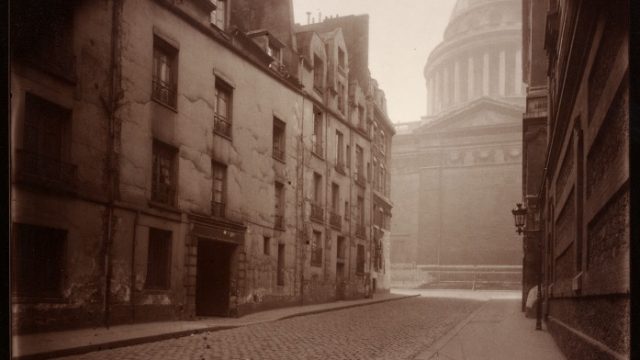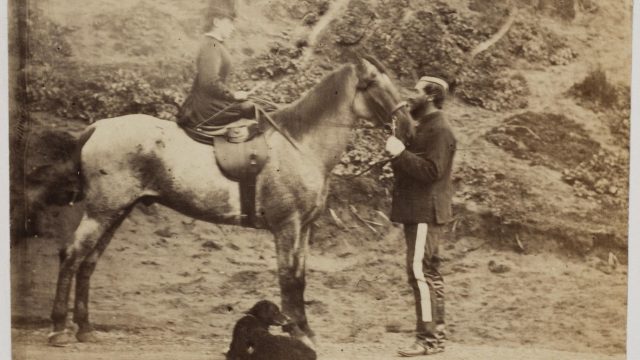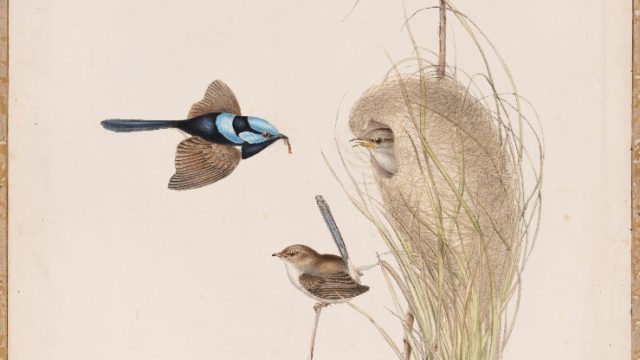It is soon to be Burns Night, providing The Factory with the perfect opportunity to dig out some of the best Caledonian-related objects in our collection, and provide a little party inspiration.
Burns Night is a delicious celebration held on the25th January, celebrating the life and works of the Scottish poet Rabbie Burns. The merriment focuses on a king-amongst-foods – haggis. This supreme concoction of sheep’s innards, oats and spices is piped in, addressed, stabbed and eventually served with neeps and tatties, allowing those present to break their honourable January intentions, and display levels of gluttony ordinarily reserved for Christmas and Pancake Day.
‘Loch Coruisk and Cuchullin Mountains, Isle of Skye’, by George Fennel Robson, 1826. Museum no. 1426-1869. © Victoria and Albert Museum, London.
This watercolour by George Fennel Robson sets the scene for revelry perfectly. It depicts Loch Coruisk and the Cuchullin Mountains on the Isle of Skye. Robson was very much inspired by Sir Walter Scott, who, at a similar time in the early nineteenth century, boosted Scotland’s tourist economy through his theatrical treatment of the Scottish landscape in his poetry and novels. This is evident in Robson’s treatment of the highland chieftain in the foreground, who gestures powerfully towards two distant peaks (possibly giving a dramatic interpretation of the Address to the Haggis?).
‘Sketch, plan and elevation of Inveraray Castle, Argyll, Scotland’ John Vanburgh, ca.1720. Museum no. E.2124:79-1992. © Victoria and Albert Museum, London.
Now we have set the scene, you may wish for your own castle in this spectacular landscape. John Vanburgh’s plans for Inveraray Castle, the seat of the Duchy of Argyle, may help. This version was never actually built, and the castle which stands today can be seen in this photograph, which some keen-eyed readers may recognise as Duneagle Castle, home of the MacClare family in Downton Abbey.
‘Inveraray Castle, Scotland’, Francis Frith, ca.1850-1870. Museum no. E.208:1706-1994. © Victoria and Albert Museum, London.
‘Tartan’, wallpaper, designed by Mary Storr, 1936-1959. Museum no. E.2421-1980. © Victoria and Albert Museum, London.
Having built your castle, you will inevitably need to decorate it. Luckily for all the aspiring Lawrence Llewellyn-Bowens out there, the V&A holds the national designated collection of wallpaper. This tartan wallpaper was designed by Mary Storr and produced by John Line & Sons, one of the leading manufacturers in the 20th century.
Fashion design, Worth, 1953-1954. Museum no. E.20697-1957. © Victoria and Albert Museum, London.
You will also need something to wear for your celebration. Not wanting to clash with your wallpaper, this watercolour design from the House of Worth’s 1954 summer collection is perfect for the lassies, showing how a hint (or slightly more), can add flair to any outfit. The full, calf-length skirt will also be perfect for ceilidhing the night away without tripping over. Lads, kilts at the ready!
‘1st Sunday in Advent’, unknown artist, ca. 1330. Museum no. 8992. © Victoria and Albert Museum, London.
In order to ceilidh you will need some music. The creature in the bottom right of this illuminated manuscript plays the bagpipes (which, admittedly, are not used in a ceilidh). It is interesting to note however, that despite the bagpipes this music sheet actually dates from the Netherlands in the 12th century.. The first explicit reference to bagpipes in Scotland appeared much later (despite what the pipers on every street corner of Edinburgh may have you believe), when George Buchanan, a Scottish historian, claimed that they had replaced trumpets during the Battle of Pinkie Cleugh in 1547.
‘Every Man on His Perch, or Going to Hobby Fair’, Isaac Robert Cruikshank, 1819. Museum no. E.1230-1990. © Victoria and Albert Museum, London.
Before you start your dancing, you may want to eat something. Having searched the collection thoroughly, I can confirm that we have nothing relating to haggis (look out for a new collection priority soon). In the absence of one great Scottish food I offer you an entertaining look at another. This etching of men on a velocipede (a Flintstone-esque forerunner of the bicycle) features a Scotsman, on the second row, one in from the left. One the back of his vehicle is not a deep fried Mars Bar, but a steaming bowl of porridge. This etching, from 1819 features a plethora of nationalities, professions and literary characters. How many can you identify?
I hope I have been able to give you some good ideas for getting into the Scottish swing of things. If you would like any further inspiration for your evening, please do come and visit us in the Prints & Drawings Study Room. Happy Burns Night!









